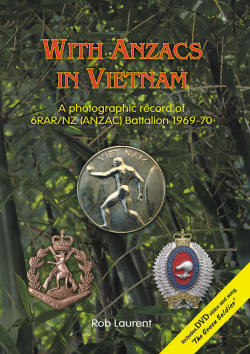|
“A
Duty Done”, Fred Fairhead [RARA SA
2014] [reviewed by Bruce Young in
January 2015] Although described as a summary of operations by the Royal Australian Regiment [RAR] in the Vietnam War 1965 – 1972 ‘A Duty Done’ is more a report on the intense infantry war fought in and around Phuoc Tuy province by the Australian and ANZAC battalions in 1ATF. Including New Zealanders 354 infantrymen died over a 7-year period, around 70% of the total Army fatalities with 2000 wounded reflecting the difficult nature of combat faced by infantry units in close country and against an enemy who 'was anywhere and everywhere', in small groups and much larger formations. Published in 2014 by the RAR Association South Australia the book commemorates three significant dates: 65th anniversary of the award of the prefix ‘Royal’ to the Australian Regiment [31 March 1949], 50th anniversary of the raising of 1RNZIR at Terendak Camp Malaysia 1 April 1964], and the 45th anniversary of the height of the RAR’s involvement in the Vietnam War [1968 - 1970]. LtCol Fred Fairhead was the former intelligence officer of 6RAR/NZ (ANZAC) on the units second tour so is well equipped to research and understand the extensive material available from the Australian War Memorial Museum and other contributors. This is an excellent book for a veteran to revise his knowledge of what happened during his tour, concise but focussed on important issues, rewarding of good leadership and disdainful of poor decisions. The maps are well prepared and attempt to identify where the action was and in what sequence; where soldiers have performed outstandingly or suffered loss these are identified both in the narrative and in a panel at the conclusion of each action. While mainly an infantry record Fred is inclusive of the artillery and armoured units without whose support the infantry would have been more cruelly under the hammer. It hardly needs to be said that in reporting the infantry war Fred has included the actions of the New Zealand company's in the same seamless manner that we experienced when with our ANZAC compatriots. However few of the W3 actions are covered in the narrative, including none where we lost people; this reinforces the need for us to maintain our own records for research purposes. Our Challenge: This lack of New Zealand information may have something to do with separate record keeping between the two ANZAC nations and suggests a need for an online archive in New Zealand to rival the facilities of the Australian War Memorial Museum, something I suggest our senior officers from the era and the RNZRSA movement in general should vigorously pursue. I for one would enjoy adding to our own record from research obtained online by browsing through the records that HQ NZ V Force surely submitted to Army General Staff. Whether this archive should be held within Archives New Zealand or at say the National Army Museum should depend on which body can best catalogue the collection and offer it online. 'A Duty Done' is 190 pages in A4 portrait with a soft cover, extensive maps and many photographs. While unlikely to be in your local library a copy can be obtained from this link - cost A$30.00
|
"No Front Line",
Claire Hall [Penguin Books 2014] [reviewed by Bruce Young in September 2014]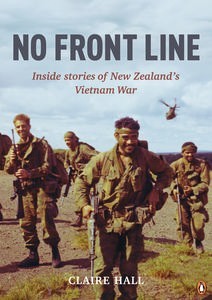 No Front Line has a sub-title 'Inside stories of New Zealand's Vietnam War' and its research draws on 150 veterans oral history interviews to illustrate military, civilian and domestic scenarios in a linked manner that reads well. No Front Line is author Claire Hall's first book and her manner of compilation has let the stories tell themselves by not embellishing or distorting the veteran's contributions. There are 291 pages and thirteen chapters with a basic timeline of deployments. The breadth of the book meant that I read details of stories that were new information, or rounded out previously heard one-liners, something I appreciated. I particularly appreciated Chapter 11 - Homecoming: Vietnam's legacy for the examples of anti-Vietnam protest and reintegration by veterans back into normal society. Some minor errors about appointments or locations does not detract from the narrative. W3 people with contributions are company medic Jim Mitchell [lolling in a hammock no less], and Peter Anderson 1Pl for his poem about the nursing sisters and Red Cross nurse Isabel Beaumont, others appear in photographs. No Front Line should be in your local library.
|
"New Zealand's Vietnam War",
Ian McGibbon [Exisle Publishing 2010] [reviewed by Bruce
Young in September 2013]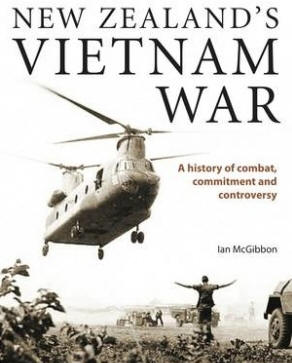 New Zealand's Vietnam War - a history of combat, commitment and controversy positions itself as 'the definitive history of New Zealand's involvement in the most controversial war of the 20th century' and given it is written by the General Editor (War History) at the Ministry for Culture and Heritage I was expecting to learn much about a war that by its nature was difficult to fully grasp. The history component of the book is over 500 pages, sufficient to pack in a lot of detail, and extensive research covering the political and strategic scene was in sufficient detail to make it clear that V Force was established to meet a political objective with the Australians rather than a military outcome with the Americans. The early chapters describing the establishment and despatch of 161 Battery and later the infantry company's is also well detailed and appreciated, as is the work for the period immediately prior to the fall of Saigon in 1975. I was able from meeting them during my later service to place many of the veterans featuring and Major Torrance, Gary Brooker, John Barkle, Craig Cocker, Wally Goodman, Duke Henry, Ian Heard and our casualties are all mentioned; the W3 website is also attributed as a reference in the notes but mis-spelt in the bibliography as www.V3vietnam.org.nz [I have hand corrected my library copy...] But as the book is likely to be the only official history of our involvement I was unhappy with the layout and some of the content:
One part of the research
appalled me. At the bottom of page 311 under
civil-military relations is a passage where an Australian
veteran recalled a journey back from Vung Tau to Nui Dat on a
truck following leave: 'I saw a Kiwi just casually pull his
grenade out and drop it over the side in all the traffic.
We all hit the deck in the back of the truck and, boom, up it
went. "Contact" someone yelled out. "Ambush".
That's it, end of chapter, turn the page for a new section
titled 'An Expanded Medical Effort'.
Yet this passage appears to describe an atrocity or war crime so
where is the details of civilians injured, the investigation, the punishment..?
Which Kiwi sub-unit is likely responsible..? Checking the
attribution reveals a curious notation 'See e.g., George Bostock, in Rintoul, P 122'. Stuart Rintoul in 1987 published
'Ashes of Vietnam, Australian Voices' a
collection of personal narratives orally recorded by the
Australian Broadcasting Corporation, a bit like our own 'Voices
from Vietnam' [I could not locate a copy of Ashes to
review]. The problem with oral recordings is that
the participant can say whatever they like and little of it is
subjected to intense scrutiny [I know as I interviewed over a
third of the NZ participants for 'Voices']. From a
research point this observation clearly deserves a proper
follow-up to discover if the statement is truthful but the
author leaves it as
simply a jarring note to conclude a chapter on. And the
'e.g.' in the reference either implies more than one Australian
witnessed the atrocity or his references are out of order,
either way not a high standard for an official history.
The person alleging the atrocity is Cpl George Bostock who
served with 4RAR between 21 May 1968 and 30 May 1969 which
narrows the timeline down considerably. I believe Cpl Bostock
to be over-imaginative and the
incident was unlikely to have occurred as grenades were not taken
on leave to Vung Tau: So while there is interesting and relevant material in the book there is also errors and omissions, such as references to W3 deploying on '13 and 14 November 1969' contrary to our actual deployment order [on the W3 website] designating two flights on 14 November, more sloppy checking. I suppose the narrative covered combat and commitment but I am unsure what is meant by controversy; I had thought it would cover the protesters but they barely got a mention so I assume this dramatic noun refers to the several blue on blue incidents which while sad are hardly controversial in a war involving close country and difficult navigation. Overall I found the book tedious and unbalanced, sparse on details about the infantry contribution and unnecessarily negative. If you find this review patchy and unbalanced blame it on the book..! You are welcome to comment here New Zealand's Vietnam War - a history of combat, commitment and controversy should be in your local library. Comment 1: Noel Benefield 1ALSG - when the Dept Internal Affairs road show was at Papakura I got the impression that they were going to conduct oral histories from everyone who wanted to participate. As it turned out they were only funded for 120 people all they considered necessary for the history. At the road show they did not make that clear. They did much later send out a simple questionnaire to others seeking a very limited contribution and this is why there are so many contributors listed in back of the book. The history was predetermined by the 120 oral histories they had chosen, in addition to archive material. Not surprising it’s so bland and unrepresentative in many areas. Comment 2: Peter Anderson W3 - I agree your comments about the Viet Nam history. I bought it after hearing a review on National Radio as it being the definitive history of the NZ involvement in the Viet Nam war. I was disappointed that there were so many unsubstantiated hearsay, maybe, could have, that I haven’t bothered to pick it up again. One item was on page 298 which slights the Maori command elements by someone called Tumai. “The Maoris were all the workers the Kahas (Pakehas) the bosses.” What utter rubbish, where is the work of Jim Brown with an Aussie company mentioned. Comment 3: Bruce Young W3 - There is a saying that the best time to accurately research details of an historical event is 40-years after it occurred when matters are less sensitive, records are declassified, emotional viewpoints have had time to settle and the bigger picture has been incorporated into the detail. Yet in my reading of 'New Zealand's Vietnam War' I find that the bigger picture has become the history rather than the other way round. I ascribe this to being caused in part by authors who are by inclination distant from the action, regarding the thoughts of prime ministers and senior officers as more relevant than the actual participants making the history. The outcome is that often military matters are trivialised or even ignored and research is soft and discriminatory, rather like modern war correspondents who believe the important action is where they are because they are there. The recording of big battles in say World War II was made easy by the hierarchical nature of commanders planning to seize ground and where decisions executed could be assessed against relevant principles of war, etc. Not so with the manner of the war in 1ATF where minor battles were fought mostly at close range and where the seizing of ground was never permanent. If the definitive history fails to reflect the sharp end trauma of soldiering for days in silence seeking to beat a very good enemy while coping with the impact of the environment, heat, humidity, flora and fauna then it is no history at all, just a comment on the times.
|
"Fighting
to the Finish", Ashley Edkins with Ian McNeill
[reviewed by Greg Lockhart VVFA]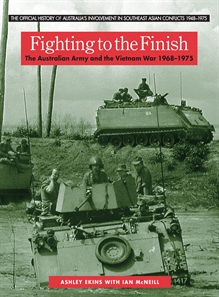 [from the publisher] "Fighting to the Finish" tells the story of the Australian Army in Vietnam during the peak years of the Australian military commitment to the Vietnam War. As the ninth and final volume of The Official History of Australia's Involvement in Southeast Asian Conflicts 1948-1975, this is the successor to the acclaimed "To Long Tan" by Ian McNeill and "On the Offensive" by Ian McNeill and Ashley Ekins. This volume describes the activities of the Australian Task Force in Vietnam during its peak years, from the middle of 1968 to the end of 1971. For most of this period, the army maintained a force of over 6000 troops in Vietnam. Eleven infantry battalions and their supporting arms undertook tours of duty and carried out almost 100 major operations. Australian soldiers fought a difficult war on several fronts simultaneously, conducting reconnaissance-in-force operations in remote enemy-dominated areas of Phuoc Tuy province, pacification operations to provide security in the populous regions, and civic action and reconstruction tasks to improve the lives of the local people and to help restore government control. The pace of operations was unrelenting and intense, and the cost was high - 250 soldiers were killed in action or died of wounds and other causes during this period. This book provides a comprehensive account of operations, actions and their context, including a fresh interpretation of the fierce clash between Australian infantry and armour and North Vietnamese Army forces in the village of Binh Ba. It also includes the most authoritative account of the clearing of the controversial barrier minefield that caused high numbers of Australian casualties. It covers the phased withdrawal of the task force as enemy pressure increased the burden and dangers for the remaining soldiers; and, for the first time, an account of the aftermath of the war in Phuoc Tuy province leading up to the defeat of South Vietnam in 1975. [about the reviewer] Greg Lockhart AATTV is the honorary historian of the Vietnam Veterans Federation Australia [VVFA] and his review of Volume 9 [follow link] was first published by Australian Book Review, September 2012; reprinted with permission by the Journal of the Vietnam Veterans' Federation of Australia, November 2012; and offered here by the author in a revised form. Veterans and scholars will be challenged by Greg's comments on the lack of political and strategic thinking essential for a successful outcome on the ground, revealing an early trend that is now all too familiar in the more recent US campaigns in Iraq and Afghanistan.
|
"Who'll Stop the Rain",
Deborah Challinor & Elizabeth Lancaster [HarperCollins 2000]
[reviewed by Bruce Young in November 2011]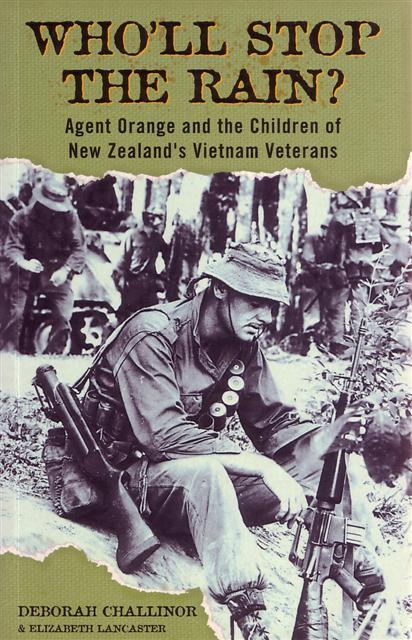 "Who'll Stop the Rain" is an early attempt to highlight the issues around how chemicals used in South Vietnam in the 1960's had affected the health of veterans and their children. I did not read the book when it was first published almost 12-years ago but chose to do so now because of recent contact with Carol the sister of Cpl Keith Henson, as Keith features in the book along with his daughter Maria and wife [now widow] Ngaire. The book has an excellent summary of the background to the decisions as to why defoliation was attempted, the nature of chemicals dispersed and the attempts by governments in New Zealand, Australia and the USA to play down or ignore the problems. Given its age it does not cover the period from 2000 until 2008 when the issues were finally and decisively acknowledged in New Zealand government and veterans circles and steps to address the issues taken. I found the book a disturbing read because of the neglect by authorities toward veterans and their families in the case studies. It is now known that the neglect was not confined to a few, and that the case studies are the tip of an iceberg. The families of veterans and others who persevered against official indifference are to be well commended and acknowledged. I believe some background concerning W3 Coy not in the book is important. It is acknowledged in Australian records that aerial spraying of Agent Orange [AO] in PHUOC TUY Province had ceased by the end of 1968, therefore the single C-123 spraying W3 Coy at the HORSESHOE in February 1970 was an anti-malarial mission, which means W3 Coy could not have suffered from the direct affects of being drenched in AO. Yet 25% of my War Disability Pension is for loss of vision in my left eye based [in the absence of other evidence] on the assumption that dioxin from AO caused the damage, a similar symptom is suffered by John Jennings a veteran interviewed in the book. So where is the AO or dioxin connection..? The book has good coverage of the effects of ground sprays released around the lines in NUI DAT but these have been generally ignored by the media in their preference for the 'sexier' image around aircraft sprays, and it is these other sprays and the lingering damage to the environment from earlier spraying, be it aerial or ground based, that I believe W3 veterans should regard as the cause of our issues. In other words we should avoid the temptation to claim aerial sprays [which can be disproved] instead focussing on the more likely weed killing or insect control sprays that we regularly encountered. While I have deep sympathy for the children affected by a legacy of AO and other chemicals passed genetically down from their father, it was the portrayal of the veterans themselves post-Vietnam which was of most interest to me. To understand that Keith drank heavily and suffered mild depression offered me a better understanding of my own behaviour following my time with W3 and I suspect that many veterans might also identify their conditions and understand their state of mind better after reading the different veterans' and children's accounts. I also think that the children of veterans might have another insight into their father's behaviour if they can now appreciate the damage done by the environment in which their father served. "Who'll Stop the Rain" should be in your local library. The co-author Elizabeth Lancaster was herself the wife of a veteran and features in the case studies.
|
|
"From Emergency to Confrontation", Chris Pugsley [Oxford Press] [reviewed by Bruce Young in March 2008]
W3 Coy was formed and trained in Malaysia. There is not a lot written about the Malaysian connection with the forces deploying to Vietnam but one book worth reading is by Chris Pugsley "From Emergency to Confrontation", a story of the two forgotten wars New Zealanders fought in South-east Asia. Chris Pugsley is a formidable researcher and this book details in minute detail the effort made by the New Zealand Armed Forces in Malaya and Borneo between 1949 and 1966, including the formation of the first regular units of the New Zealand armed forces, and the development of Terendak garrison. Some W3 worthies whose early service is mentioned by name are Jim Brown [including how he obtained his Military Cross] and Doug Mackintosh [misspelt DI Macintosh, original SAS Malaya and later Borneo Signals Pl]. The New Zealand contribution of naval and air force units is also covered and some of their activities may surprise - such as 14 Squadron RNZAF Canberra bombers in Singapore rehearsing their role for a pre-emptive strike against airfields around Jakarta during the early days of Confrontation. I was also not aware of the extensive nature of cross-border operations [codeword Claret] undertaken by Gurr's battalion in Borneo, although news of the SAS Claret operations was more widely known.
Of most relevance to jungle bashers is the way in which New Zealand developed the expertise in close-country operations that served us so well in Vietnam. Our style of small group tactics started with the New Zealand assistance and mentoring to the Fijian battalion 1952 - 1956, were later developed by the original SAS deployment 1955 - 1957, and enhanced by later infantry battalions during their operations on the Thai border, in the Johore swamps, and across the mountainous terrain in Sarawak. Veterans will recognise in the stories many names of those responsible for training and testing us. Also interesting was the way New Zealanders went in droves to the conflict, learning mostly after their arrival how best to do the job. But the book shows how the New Zealand effort was often the best of all the units deployed, on either side of the conflict.
Another overriding theme is summed up by Colonel David Moloney a former commander of the 4th SAS deployment to Borneo, who commented "that for a very tiny country ... with a tin-pot little army, we really do extraordinary things". The book exposes the way the Holyoake government's forward defence planning developed the art of promising to do - and indeed doing - much with little. Considering we were among those doing the much with little, the book makes interesting reading.
"From Emergency to Confrontation" should be in your local library.
Voices from a Border War, Robert Gurr [Landmark Printing 1995] [reviewed by Bruce Young] This book is written by the then CO of 1RNZIR 1963 to 1966 Brigadier Bob Gurr and is a factual account of the preparation and commitment to active service of a New Zealand battalion against the Indonesian confrontation with Malaysia. It uses a wide range of recollections of members of the battalion as well as official records, war diaries and post operational reports to authenticate dates and events. Chris Pugsley the author of "From Emergency to Confrontation" read the early drafts and offered advice. The book is very even paced and under-stated, typical of the manner Kiwi troops adopted when working alongside allied forces. Yet the detail is clear and the events vivid because of the personal stories of those involved. Claret operations despite their sensitivity are covered in a routine operational vein and results are reported in a matter-of-fact way. A number of people mentioned in the chapters will be familiar to W3 people. Voices from a Border War should be in your local library.
Greg Lockhart describes it as a story of strategic self-destruction. Lockhart, today the honorary historian of the Vietnam Veterans Federation Australia [VVFA], was a member of AATTV and was himself blown up by a command detonated mine while with a RF/PF patrol; draw your own conclusions from that. 40-years after the 1ATF minefield was laid from the Horseshoe to the coast, Lockhart reveals from exhaustive research through official records and interviews the twisted thinking that led to 1ATF arming the very enemy we were sent there to fight. The book reveals how the Australian CGS FLEW over Phuoc Tuy before deciding it was a suitable piece of turf to have a war on. How Australian intelligence never understood the enemy, or the local provincial administration, or the sympathies of the local population. How techniques from Malaya and Algeria were introduced as war-winning ideas when in reality the campaigns had nothing in common. How two 1ATF battalion commanders with relevant experience in Korea and opposed to the minefield concept were ignored, and how staff in Australia were unable to promote views that were contrary to those of the original minefield planners. Lockhart reveals how arming the VC from the minefield cost many Australian and Kiwi lives. In 1967 two 11 KM wire fences were erected 100-metres apart as the minefield boundaries. 20,292 powerful M16 mines were laid, approximately 12,700 with anti-lifting devices [grenade underneath connected to a switch]. Yet in 1970 when the minefield was finally removed only around 12,000 mines could be accounted for and a figure of approximately 7000 mines were attributed to being lifted by local people sympathetic to the VC cause. 55 members of 1ATF [5 NZ] were killed by mines from the field, 250 [13 NZ] wounded. In 1969-70 over 50% of 1ATF casualties were by M16 mines, a single M16 mine on several occasions gutting a platoon. But Lockhart also reveals the heroism of the diggers in dealing with the laying and aftermath of the minefield, including the original field engineers who laid the field despite suffering fatal casualties caused by rushed preparation and faulty mine fuses. He provides names and the circumstances of those killed, and the effect on those fortunate to survive. He pulls no punches over poor decision making, grandstanding and obstruction by senior officers, and he reveals the commonsense approach taken by soldiers and unit commanders to finally remove what was left of the minefield threat. It was almost a relief to read about the final day of mine clearing, considering one local interviewed had personally removed 2000 mines, and that mine lifting efforts by locals was increased in front of the mine clearing teams as they worked their way along between the fences. And in case veterans thought otherwise, the research confirms that the VC and local population were not as stupid as some would portray them. My copy of the book was from the local library - there are very good maps, lots of photos and very good appendices.
The book is interesting for three other points: 1) it covers how the Australians tactically removed themselves from Nui Dat and the demise of the brigade-sized base, 2) 4RAR were proud to be an ANZAC unit and their story treats V6 Coy in a very positive and inclusive manner, illustrated by the foreword being written by the then Kiwi bn 2ic Maj [later LtGen] Don McIver, and 3) the background on the enemy ORBAT is well written and easy to understand. I found the book absorbing and finished it in 48 hours, a really good read and very recommended.
"The Vietnam Years - From the Jungle to the
Australian Suburbs", Michael Caulfield [Hachette Australia].
Michael interviewed a wide range of veterans and veterans’ wives to give the story of how conscription affected individuals, their families and their communities. He writes from the perspective that Vietnam was different from all other wars that diggers had been sent to: "At the end of it there is one harsh, unpalatable fact that separated this war from all the others: for the first and only time in our history Australian soldiers were sullied and defamed by their own people for carrying our name into battle. Whatever the reasons, Vietnam as a term, as a memory, still carries a volatile charge and careless handling can cause instantaneous detonation." He describes the Vietnam War as being two wars, the one we fought in, the other the war watched in rising discord and discontent at home.
The book covers the WW2-type military psyche of our parents, the manner in which Australia became embroiled in the US-led war, the effect of conscription and the manner in which 'nasho's' acquitted themselves, and many good yarns which could easily come direct from our own stories. Long Tan is covered in excellent detail, as was the futile effort to motivate the locals toward the US style of fighting. It finishes with the last days of the Republic and the confusion back in Australia as servicemen discovered their poor standing among their peers and even the old soldiers. The title of the final chapter may have summed up the feelings of veterans throughout the book "If we look like having another war, send the frigging politicians".
480 pages but worth the effort.
This is a military history written from the perspective of the soldier by the soldier, of the life of V4 Coy in SVN from May 1969 until the present day. The contributors sought to capture their experiences for the generation that will follow them, and as a testament to the seven who lost their lives while with them on active service. W3 Coy were present in 6RAR/NZ (ANZAC) with V4 Coy for the latter half of their tour; although we didn't see a lot of them due to different deployments in-theatre we had trained with most of them individually and knew them well. From their accounts they acted [if not dressed] like us and suffered similar conditions. Where we differ is that V4 lost seven dead and were occasionally involved in action against larger groups of VC. They acquitted themselves well. The editorial committee recognised the personal emotions in individual stories and chose to leave the stories as written by the veteran involved, an effective means of getting the raw facts into print if a little boring reading that the Company deplored on certain dates from almost every contributor. There are novel contributions about each of the deceased, and many references to places and activities that we were familiar with, involved in or waiting close by. Having stood sentry on the perimeter of V4 Coy Nui Dat lines one night and hearing the story of the python in the bunker, it was illuminating to read that the story was not a rumour designed to keep us awake..! The book does not attempt to describe the Vietnam war in any historical perspective, suffice to say that all one gets from reading it is memories of the conditions under which we all served, and the sacrifices we all made in one way or another. 300-odd pages with 26 chapters, enough photos and few maps, the book is worth a read. I got mine from the public library.
40-years on, our stories will now
be told, part of a poem by Pte W [bulldog] Te Awa, who promoted the idea of the book, and who raised the funds to achieve it [First Sovereign Trust]
Reviewed by Peter Anderson on 5
March 2012 As we were part of 6RAR/NZ (ANZAC) Bn for the last six months of V4s tour we knew a lot of the company and Lt. Stan Kidd went to V4 from us as B Coy in Terendak and there is a report on the contact that he was killed in. There is post-Vietnam reunions and other group photos. The V4 tour mirrors W3's tour in a lot of ways and the places and names are familiar to us all. Well worth the read.
With the ANZACS In Vietnam
- Reviewed by Peter Anderson
in
March 2012 With ANZACs in Vietnam features hundreds of colour and black-and-white photographs taken during the war by sixteen Australian and New Zealand members of 6RAR/NZ. Most of the photos have been stored in private collections since that time, unseen by the public. Forty-one years on they have been assembled here to show today’s generations how Australian and New Zealand soldiers lived and fought during the most controversial war of recent times. The Australian Army's 6th Battalion was the unit that fought with such distinction at the Battle of Long Tan in 1966. When the 6th Battalion returned to Vietnam for its second tour of duty in 1969 it was supplemented with two companies of New Zealand infantry, forming the ANZAC unit 6RAR/NZ. The author served in Vietnam as a Company Medic with 6RAR/NZ during 1969-70.
|
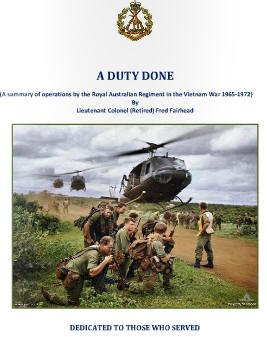
 [reference
[reference

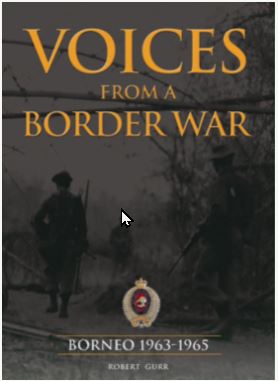

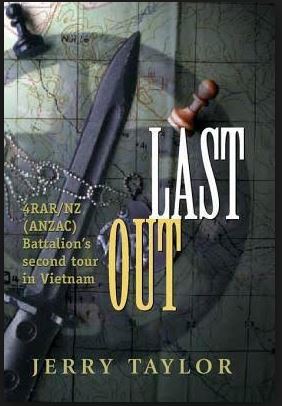 Have just finished the book 'Last Out, 4RAR/NZ (ANZAC)
Battalion's Second Tour in Vietnam' by Jerry Taylor [Taylor
was OC Admin Coy for part of the tour]. The book deals with the
4RAR/NZ (ANZAC) 2nd tour from May to December 1971 and ends with
the battalion being the last to leave Vietnam, abandoning Nui
Dat on 7 November and Vung Tau on HMAS Sydney on 8
December [the
Have just finished the book 'Last Out, 4RAR/NZ (ANZAC)
Battalion's Second Tour in Vietnam' by Jerry Taylor [Taylor
was OC Admin Coy for part of the tour]. The book deals with the
4RAR/NZ (ANZAC) 2nd tour from May to December 1971 and ends with
the battalion being the last to leave Vietnam, abandoning Nui
Dat on 7 November and Vung Tau on HMAS Sydney on 8
December [the 

